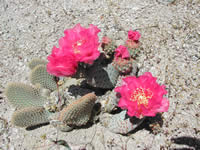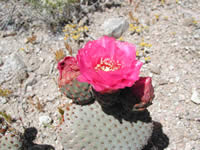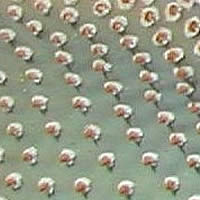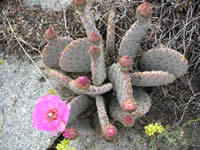Plant of the Week
 Range map of prickly pear. States are colored green where the species may be found.
Range map of prickly pear. States are colored green where the species may be found.
 Beavertail cactus plant and flowers. Photo by Sue Weis, Inyo National Forest.
Beavertail cactus plant and flowers. Photo by Sue Weis, Inyo National Forest.
 Close-up of bevertail cactus flowers. Photo by Sue Weis, Inyo National Forest.
Close-up of bevertail cactus flowers. Photo by Sue Weis, Inyo National Forest.
 Close-up of pad and spines. Photo by Sue Weis, Inyo National Forest.
Close-up of pad and spines. Photo by Sue Weis, Inyo National Forest.
 Another photo of a cactus with lighter flowers. Photo by Sue Weis, Inyo National Forest.
Another photo of a cactus with lighter flowers. Photo by Sue Weis, Inyo National Forest.
Prickly Pear (Opuntia basilaris P. Mill.)
By Forest Jay Gauna
The genus Opuntia (particularly the subgenus Platyopuntia, or “flat-Opuntia”) is a well-known symbol of Mexico and the American Southwest. The prickly pear (nopal, in Spanish) has the distinctive shape of fleshy oval pads (pencas) growing one atop the other. Most have defensive spines (sometimes large, sometimes small) growing out of the pads, menacing would-be Opuntia eaters and providing humorous stories for many rural Southwestern families, who often repeat tales of a relative’s encounter with one of the low-growing varieties.
Besides being known for their spines, prickly pears are also known for their universally beautiful flowers. Pretty flowers are a common trait throughout the Cactaceae (Cactus family) and have inspired much poetic and philosophical reflection because of their contrast with the unfriendly-looking spines that are also a common trait throughout the Cactaceae. Prickly pear flowers can be easily recognized by their numerous and colorful tepals (not necessarily uniform, but grading from spiny sepals to petals) and their often showy and numerous stamens. They are also easy to recognize because they are growing on top of prickly pears.
Uses of prickly pear are varied and many. Its primary use to humans is as food. The young pads are stripped of their spines, boiled and eaten as nopalitos; its use as a vegetable is widespread in Mexico and the Southwest, and has been one of the most important sources of food in this area since ancient times. The fruit (tuna) is also eaten in various ways and is quite nutritious. Both are good sources of dietary fiber.
Another common use of the nopal is for natural, low-maintenance, edible fencing. Using a spine-burner (chamuscadora), prickly pears can be made into livestock forage during droughts. The sticky sap (a defense against insect predation) has many uses, from emergency wagon-wheel lubrication to fortifying mud bricks. The nopal has many traditional medicinal uses, but in modern times has been much studied for its ability to help control blood sugar levels in diabetics.
Because of its importance as food and medicine, as well as its unique appearance, the nopal has acquired much symbolic value. One appears on the flag of Mexico, and the state website of New Mexico greets web surfers with a crimson-flowered prickly pear. Many Opuntia spp. are native to the United States, and most (if not all) to North America. The generic name, given by Phillip Miller in 1754, may derive from the Papago name for the plant (opun), or from an unrelated spiny plant near the ancient Greek city of Opus.

